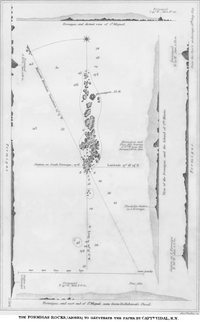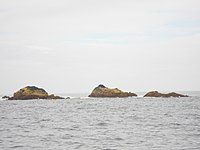Formigas
Template:Geobox The Formigas (Ants) Islets (Portuguese pronunciation: [fuɾˈmiɡɐʃ]), sometimes referred to as the Formigas Bank, are a group of rock outcroppings in the eastern group of the Azores archipelago, an autonomous region of Portugal. The bank is located 43 kilometres (27 mi) northeast of Santa Maria Island and southeast of São Miguel Island covering a surface area of approximately 9,000 square metres (97,000 sq ft). In the same area is the submerged Dollabarat Reef. The bank is disturbed only by a lighthouse located on the largest mound.
History

The Formigas were discovered by Diogo de Silves and Gonçalo Velho Cabral during 1431, during their journey to Madeira. They were neglected due to the discovery of the larger islands of Santa Maria and São Miguel during the years ensuing. Gaspar Frutuoso, the Portuguese chronicler, reported during the 16th century of the rich marine life.
The first scientific vessel arrived during 1886: the Italian ship Corsaro visited the Formigas islets; the first scientific dredging being made then. The Princess Alice expedition also stopped during 1895, as did several others, mostly to investigate the marine life: scientifically and commercially.
On 2 March 1895, at the General Meeting of the Autonomous District of Ponta Delgada, the construction of lighthouses was initiated for the islands of São Miguel and Santa Maria. A lighthouse was built on the Formigas the same year. During 1948 a small uncovered wharf was built. The lighthouse was further modernized, then rebuilt during 1962 by a shipmaker Almirante Schultz Xavier. It is located in the southern part of the Formigas in a zone that is approximately 3 metres (9.8 ft) above the mean sea level: it sits 22 metres (72 ft) above sea level. The lighthouse has been updated since 1962 (most importantly with photovoltaic power replacing acetylene). It marks the characteristic profile in the oceanic landscape of the Formigas. It can be sighted from 22 kilometres (14 mi), presumably, during days of normal visibility, although there have been cases of seeing the lighthouse from the southeastern part of the island of São Miguel and the northeastern part of the island of Santa Maria.
Since 4 April 1988, the Formigas Bank has the status of Nature Reserve and is protected by a decree of the Azorean Regional Assembly (Regional Legislative Decree Nº11/88/A), but it is also considered a European Site of Community Importance (Rede Natura 2000). The habitats included in the Azorean decree include the area from the emerged islets to depths of more than 1,700 metres (5,600 ft), yet this has not stopped incidence of commercial fishing. Consequently, the zone is patrolled regularly by a Portuguese naval vessel based in Ponta Delgada.
Geography

These outcrops are composed of basalt flows of 4 million years, although there have been discoveries of calcareous fossiliferous sediments of 4-6 million years. The bank extends for 13 kilometres (8.1 mi) from northwest to southeast and is 5.5 kilometres (3.4 mi) wide. Additionally, due to strong currents and frequent large swells the linear rock outcroppings lack any terrestrial flora or fauna. Along their perimeter, the seabed drops steeply to a depth of 50–70 metres (160–230 ft)on either side, and gently at the northern and southern tips. The area of the Bank referred to as the Dollabarats reef, is an area of shallower gradient situated 5 kilometres (3.1 mi) along the southwest of the Formigas Islets.
The name Formigas is Portuguese for ants, since these geological features are small and dispersed rocks in the ocean, like disorganized ants. The largest islet, Formigão (or literally "large/enormous ant"), reaches 11 metres (36 ft). Generally, the islets are useful for navigation and visible up to 19 kilometres (12 mi) away on clear days, but during intemperate weather a ship can run aground without even seeing the lighthouse.
Biome
The Formigas Bank is essentially a submarine volcano, inhabited by deep-dwelling marine species, coral and sponges.[1] The cone is delimited approximately by the islets of the northwest and the Dollabarats reef to the southeast.[1] In the ancient crater there is a rich community of species common to the Azores. Among the species typical of the area are wrasse (Mediterranean rainbow wrasse, ornate wrasse), damselfish, sergeant fish (yellow and black), grouper, Mediterranean parrotfish, and the emblematic Atlantic goliath grouper, Serranidae and barred hogfish.[1] Alongside these are pelagic predators that also reside in the bank (African threadfish, longbill spearfish) and migratory species that travel between destinations (like the manta ray and whale shark).[1]
The base and surface of the volcano is covered in various types of black coral and soft corals, sponges and other invertebrets, and various algaes, forming a mosaic of micro-habitats.[1] The great geological difference between the islets and Dollabarat are accentuated between both areas: there are two types considered unique to the archipelago of the Azores and sustained by an elevated biomass of brown algae: the fields of kelp, situated between 45 metres (148 ft) and 60 metres (200 ft) depths below the crater, and the brown alage along the flanks of the Dollabarat reef.[1]

References
- Notes
- Sources
- Rodrigues, Manuel Maria Sarmento (1970). Ancoradouros das Ilhas dos Açores (in Portuguese) (3 ed.). Lisbon, Portugal: Instituto Hidrográfico. p. 255.
{{cite book}}: Unknown parameter|trans_title=ignored (|trans-title=suggested) (help) - Vidal, Alexander (1849), "The Formigas Bank, near Santa Maria (Azores)", Journal of the Royal Geographical Society of London, vol. 19, London, England: Royal Geographical Society, pp. 160–166
- Ávila, Sérgio P.; Azevedo, José M.N. (1997), Shallow-water Mollusks from the Formigas Islets, Azores, collected during the Santa Maria e Formigas 1990 Scientific Expedition, Açoreana, pp. 323–330
- Christiansen, Sabine; Tempera, Fernadno, The Formigas Bank - A Potential MPA, Washington, D.C., United States: WWF World Wildlife Fund
- Afonso, Pedro (September 2010), SRAM (ed.), Banco das Formigas (PDF) (in Portuguese), Horta (Azores), Portugal: Secretária Regional do Ambiente e do Mar, retrieved 6 October 2012

